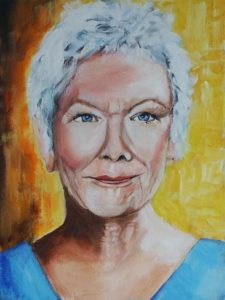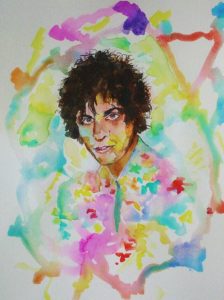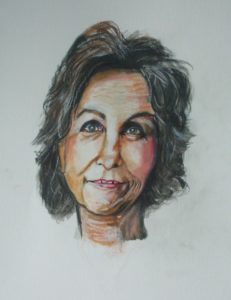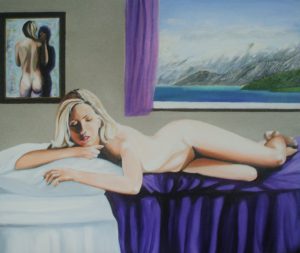I’ve lost confidence in the last few weeks about my ability to achieve consistently good likenesses with my portrait painting. My success rate at the moment in the last three attempts is not good – Dame Judi Dench poor, Syd Barrett poor, Dame Paula Rego reasonable. Some artists are able to turn things around and convert bad starts into good finished work. In my case, if I begin badly I can rarely get it right no matter how much I try; with the two failures I’ve spent hours trying to change them for the better and the most frustrating aspect of it I can’t spot anything major that makes the paintings fundamentally incorrect! Here’s the point I’ve reached with these works:-

Dame Judi Dench
All three paintings are quite small and so far I’ve spent about 9 hours trying to sort Dame Judi out!

Syd Barrett (formerly of Pink Floyd)
With Syd Barrett , the same amount of time has probably also been consumed trying to make the face right without any attention to the background and shirt! I can see that the eyes and nose are the problems and I might now have to paint over them and start again or abandon the portrait for now and try much later.

Dame Paula Rego
Although only a very quick sketch (mixed media), this is a better likeness of Paula Rego as she was about ten years ago when I sat with her for a while in the restaurant at the Royal Academy of Arts and spoke with her for about 15 minutes.( I think I was the only person in the crowded restaurant who knew who she was!) I discovered her to be an absolutely charming person, so kind, unassuming and very helpful. She stressed the importance of drawing to me and I’ve since discovered from a recently televised documentary made by her son on her life what an incredibly full, and at times difficult, career she has had. I told her during our chat that I loved her work and found out that she was in the process of hanging some prints for an exhibition at the RA. She also said some nice things about some of my paintings as I had copies of a few with me at the time which she commented on positively. I have never forgotten this encounter as she was so modest, quietly spoken and seemingly shy but quite willing to talk to me.
Paula Rego comes from Lisbon in Portugal and from 1952 to 1956 went to the Slade. She developed into a powerful story teller of fairy tales mixing images of women, children, men and animals in surrealistic scenes using strong, vivid colour and a bold drawing technique. In her early life in Portugal she lived in a male dominated society; many of her early experiences as a child and as an art student in the UK are embodied in her themes using acrylic and pastel. The majority of her female figures are stocky, swarthy and slightly ferocious looking and constructed in her own very distinctive manner.
The wonderful storytelling paintings of Paula Rego reminded me of songs which are narrative so I decided to abandon portraiture for a while and start on a work inspired by The Other Woman written (words and music) by Jessie Mae Robinson in 1955. It’s a story of infidelity, a married man with a mistress who knows that he will never leave his wife and children and that she will eventually be left on her own. It’s a beautiful sad song describing the well ordered life of the other woman who is free to live a seemingly glamorous trouble-free lifestyle with fashionable clothes, perfume, fresh cut flowers in every room and a tidy house with no toys to clear away in the evening. There is time to manicure her nails and visit the hairdresser whenever she wants. She waits for her lover’s visits yet always cries herself to sleep when not with him, knowing she will never be able to have him for herself. I tried a painted interpretation some years ago that didn’t really work and here’s where I’ve got to with the second attempt where the mistress lies on her bed thinking about her situation. The setting is fairly luxurious somewhere near a lakeside in central Europe and I’ve imagined it’s a long distance relationship so that her lover’s visits could be related to business trips – he doesn’t actually appear in the painting but is represented by the shadow in the picture on the wall.

The Other Woman
There is still some more refining and a few changes to be made and as usual I’m having difficulty with my flesh painting of the reclining nude and the transition from light to dark.
Here is the song sung by Anne Sofie Von Otter from the Album Von Otter meets Costello.